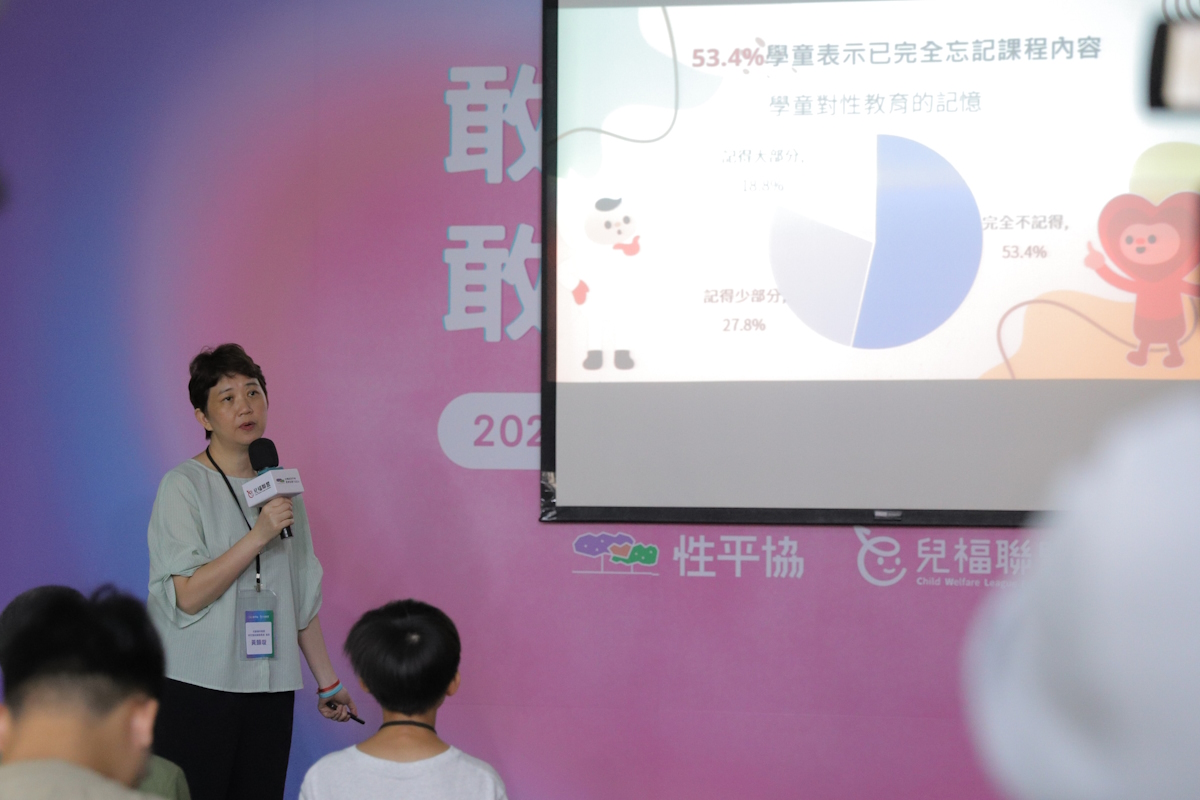
CWLF Survey: Children Score Low on Sexual Knowledge and Need Comprehensive Sexuality Education
“Why do girls bleed?” “What is a wet dream?” “Can same-sex couples get married?” When faced with such questions from children, many adults choose to dodge or brush them off. Yet in an era shaped by the #MeToo movement, a surge in child sexual abuse materials and sextortion, and a 78% increase in reports of sexual exploitation of children under 12 within three years [1], how can silence in sexuality education keep children safe?
Gender equality education has been incorporated into Taiwan’s Curriculum Guidelines of 12-Year Basic Education as a core theme, becoming a matter of growing concern for today’s parents. But what are children actually learning? And what is missing?
In collaboration with the Taiwan Gender Equity Education Association (TGEEA), Child Welfare League Foundation (CWLF) conducted a nationwide survey among fifth- and sixth-grade elementary school students [2]. In July, we co-hosted a press conference titled “Talking About Sex Without Shame, Teaching About Love with Confidence” and released the 2025 Survey Report on Comprehensive Sexuality Education (CSE) for Children in Taiwan.
The findings were concerning: students scored an average of only 53 points, with nearly 60% failing. More than half (53.4%) said they had completely forgotten what they learned in class, while parents generally avoided discussing sex. As a result, nearly half of the children relied on the internet for sexual knowledge. These informal sources contributed to widespread menstrual stigma and gender stereotypes. One in four students reported having been in a romantic relationship, yet nearly 40% had never thought about personal boundaries, indicating a lack of awareness of consent and boundary setting.
At the press conference, representatives from TGEEA, the Not So Tiny Alliance, and CWLF, together with two 5th-grade students, highlighted the wide gap between current sexuality education and children’s real needs. We called on the government to strengthen curriculum standards, schools to create supportive learning environments, and parents to have open conversations. Let’s transform sexuality education into practical life knowledge and a way to safeguard children.
[1] Source: Department of Protective Services, Ministry of Health and Welfare. https://dep.mohw.gov.tw/dops/lp-1303-105-xCat-cat05.html
[2] Using stratified cluster random sampling, the survey was conducted from March 26 to April 23, 2025. A total of 1,840 questionnaires were distributed, and 1,426 valid samples were collected, yielding a response rate of 77.5%. With a 95% confidence level, the margin of error does not exceed ±2.59%. The sample consisted of 50.1% boys, 48.9% girls, and 1% identifying as other. Among them, 42.5% were fifth-grade students and 57.5% were sixth-grade students.
Elementary School Students Generally Lack Sexual Knowledge, with an Average Score of Only 53
This survey included 11 questions related to personal development for fifth- and sixth-grade students [1]. The results showed that students answered an average of only 5.9 questions correctly, equivalent to 53.1 out of 100 points. In fact, as many as 58.9% of students failed (scoring fewer than 7 correct answers, or below 63.6 points), indicating that overall sexual knowledge levels are low. Only 2% of students answered all questions correctly.
The questionnaire item with the highest error rate was “Wet dreams usually occur regularly,” which 74.8% of students answered incorrectly, followed by “Most girls experience their first menstruation before the age of 10” (62.4%) and “Women do not have periods during pregnancy” (54%).
In addition, the survey found that students were less familiar with the physical development of the opposite sex. Among boys, 74.4% misunderstood menstruation, while 77.7% of girls knew little about wet dreams. Such misconceptions about the physical development of the opposite sex may cause children to feel fear or disgust toward puberty changes, or even respond to gender characteristics with mockery, which could lead to gender discrimination or bullying.
[1] The CSE Awareness Questionnaire included positively-worded items such as: “If you experience sexual harassment, sexual bullying, or sexual assault, you can call 113 for help.” ”Pregnancy begins when an egg and sperm combine and implant in the uterus.” “There is no menstruation during pregnancy.” “There are more than just two genders (male and female) in the world.” “According to the Convention on the Rights of the Child, children have the right to express their opinions and may have different views from adults.” “Proper use of condoms can reduce the risk of pregnancy and sexually transmitted infections.” “People of any gender may masturbate, and this is a normal behavior.” The questionnaire also included reverse-worded items, such as: “Most girls experience their first menstruation before the age of ten.” “I will only treat classmates well if they treat me well first.” “Men should wear tight pants to protect their genitals.” “Wet dreams usually occur regularly.” All 11 questions were presented as single-choice items with three options: true, false, or unsure, and answers marked as “unsure” were counted as incorrect.
What They Learn in School Is Quickly Forgotten! Nearly Half of Students Rely on Google for Sexual Knowledge
The survey found that students perceived their main sources of sexual knowledge to be teachers or textbooks (82.5%), parents (55.5%), online searches by themselves (49.8%), YouTubers or influencers (31.2%), and social media (26.5%), showing that emerging media also plays a notable role. While the sources are diverse, their accuracy is concerning. Further analysis revealed that students who learned from teachers or textbooks answered more questions correctly (6.1 questions) compared to those who did not use these sources (4.9 questions), highlighting the importance of formal education as a source of sexuality education.
It is noteworthy that although school curricula are the primary source, more than half of the students reported having completely forgotten what was taught (53.4%), with only 18.1% claiming to remember most of the content. This indicates that current teaching is either not well implemented or insufficiently connected to real-life situations. Moreover, because the content of sexuality education is not included in exams, students show low motivation and limited learning outcomes.
On the other hand, nearly half of the students relied on online searches for sexual knowledge, reflecting that the information provided in schools does not meet their needs. However, this also exposes children to risks of inaccurate, biased, or even gender-prejudiced information. Without proper guidance, these students may develop misunderstandings or misconceptions about sexuality and gender.

Many Parents Avoid Talking About Sex, Yet Their Attitudes Have a Profound Impact on Their Children
In addition to school education, children’s understanding of sex and gender is also deeply influenced by the adults around them. The survey identified three types of adult attitudes and communication styles.
The first type is the “avoidance type,” where 62.8% of students said that the adults at home had never proactively discussed topics about gender diversity, such as “The gender of a future partner does not matter.” Additionally, 43.1% had never talked about transgender, and 46.3% had never discussed HIV-related knowledge, showing that most adults tend to remain silent on gender-related topics.
The second type is the “stereotype type.” The survey found that 43.5% of children had heard statements such as “Dating and sex should wait until you grow up,” and 45.8% had heard that “After you enter puberty, you will be interested in the opposite sex.” These statements reflected the belief that romantic relationships can only occur between opposite sexes and at certain ages. There were also incorrect statements that link HIV with fear, such as “HIV is only transmitted through sexual activity” and “You should stay away from infected friends,” which may deepen children’s prejudice toward both the disease and sexual minorities.
In contrast, the third type of adults demonstrates respect for diversity and a willingness to communicate. For example, 54.2% explained to children that “Some people in the world are transgender,” and 44.1% mentioned that “People may have different romantic or sexual experiences before marriage.” These positive conversations help children develop an understanding of differences and a respect for diversity. Further analysis showed that when adults have a more open attitude, children also exhibit more diverse and open gender perspectives, confirming the critical influence of adults’ attitudes and the atmosphere in the environment on children’s value development.
Is Menstruation Embarrassing? 35.5% of Students Still Hold Stereotypes
Children’s perceptions of gender and the body are still deeply influenced by social prejudice and traditional stereotypes. The survey found that 39.5% of students agreed with the statement “When adults pat me on the head, it is a friendly gesture and nothing is wrong,” indicating a need to strengthen awareness of bodily boundaries and personal autonomy. Also, 35.3% believed that “It’s less embarrassing if sanitary pads are kept out of sight,” reflecting the persistence of menstrual stigma. The menstrual stigma can cause girls to hesitate to seek help when experiencing discomfort and make it harder for boys to understand girls’ physiological needs, leading to teasing or exclusion.
The survey also revealed that 81.5% of children agreed that “People of the same gender can be friends and can also date,” suggesting that most students have a basic understanding of gender diversity. However, 19.4% believed that those who face gender discrimination should change themselves to avoid being discriminated against, indicating that nearly one in five students still hold internalized prejudice. Further analysis showed that students with higher scores in sexual knowledge also demonstrated more accurate gender attitudes, underscoring that promoting CSE not only enhances knowledge but also helps build values of respect and understanding for diversity.
Facilities on campus also reflect how well gender diversity is accepted. The survey found that only 30.4% of students had ever used all-gender restrooms on campus, while 26.7% said such facilities existed but they had never used them, and nearly 23.7% did not even know if their school had such facilities. Further results showed that 79.5% of students cared most about the safety of all-gender restrooms, followed by clear signage (64.9%). These findings indicate that there is still significant room for improvement in both infrastructure and the promotion of inclusive attitudes toward gender diversity in schools.

One in Four Elementary School Students Has Been in a Romantic Relationship, but 40% Do Not Understand Boundaries
The survey revealed that fifth- and sixth-grade elementary school students already show clear interest and experience in romantic relationships. Among the students, 24.2% said they “want to be in a relationship now,” while 23.1% reported having been in a romantic relationship before, meaning one in four students is currently or has previously been involved in dating. When asked about ideal partner traits, the most valued qualities were “easygoing personality” (76.2%) and “good conversation” (69.9%), followed by “good looks” (60.8%), indicating that students already have initial expectations for relationships.
As for where partners came from, 80.8% dated school classmates, followed by online acquaintances (15.8%), people introduced by friends (10%), and cram school classmates (9.7%), showing that most relationships stem from daily social circles. A noteworthy new trend is that 6.6% of students reported having been in a relationship with virtual or two-dimensional (anime) characters.
The survey also asked about boundaries in romantic relationships and found that students still lacked a clear understanding of acceptable physical contact in relationships. About 35% said they were comfortable with hugging, 11.6% accepted kissing, and 3.5% said they were okay with sexual activity (higher than the 1.8% recorded in the 2022 survey [1]), indicating a shift in attitudes toward intimacy that warrants attention. Additionally, 13.7% said they were entirely uncomfortable with any physical contact, and 38.7% said they “had never thought about it.” This suggests that nearly 40% of students have not formed clear thoughts on physical boundaries in relationships, which could make it difficult for them to respond or say no when facing unexpected advances, posing potential risks.
Further analysis showed that students who had established clearer relationship boundaries also scored higher on CSE knowledge (6.2 correct answers compared to 5.4 among those who had never considered boundaries). Moreover, students without a concept of boundaries often came from environments with less open gender attitudes, indicating that when children lack opportunities to discuss relationships and gender with adults, they are also less likely to develop bodily autonomy and decision-making skills in social interactions.
[1] Source: CWLF’s 2022 Survey on Children’s Perceptions of Romantic Relationships and Emotional Education
Starting From Children’s Real-Life Experiences to Build Practical, Everyday Sexuality Education
At the press conference, two fifth-grade students, Sophie and Ethan, also shared their observations and thoughts on affections, romance, and gender issues. Sophie mentioned that she is curious and confused about romantic relationships, and that she hopes to learn how to identify situations such as “toxic partners” or “PUA (pick-up artists)” before actually starting to date. This, she said, would give her more confidence to face relationships and help her learn to stand by her own views and respect mutual boundaries.
Ethan said that although he has liked someone before, he feels that his age is not yet appropriate for dating, so he never confessed his feelings, though he has been confessed to. While some classmates have dating experience, he currently has no strong desire for a romantic relationship and instead focuses more on how to politely reject others and avoid hurting them. Both students emphasized, “Whether it is holding hands, hugging, or engaging in more intimate physical contact, mutual consent is essential.”
When discussing gender stereotypes, Sophie said she often notices subtle discrimination in daily life, such as beliefs that women should stay at home while men go out to work, or even mockery of natural phenomena like menstruation, which makes her feel there is still a lot of unfair judgment in society. Ethan also shared that he had once been mocked by classmates for having a “girly voice,” which made him feel hurt and disrespected. These experiences show that children not only have their own understanding of romantic relationships and bodily boundaries but are also facing gender pressures and judgments from school and society, highlighting the urgent need for greater support from both educational settings and families.
TGEEA Deputy Chairperson Po-Yuan Wang emphasized that CSE aims to strengthen children’s overall learning in gender, emotional, and physical development. “The current survey helps us understand what children are actually learning, the gaps in knowledge, and common misconceptions,” he said. “Such data enables teachers and policymakers to align with international trends and better understand what children in Taiwan truly need in sexuality education. Only by starting from children’s real-life experiences can we design courses that are relevant to their lives and truly useful.”
TGEEA board member Ying-Fan Chiang shared her firsthand experience teaching sexuality education to elementary school students in alternative education and co-learning groups. She noted that fifth- and sixth-grade students are very curious about topics such as menstrual stigma, wet dreams, the functions of reproductive organs, and questions like “Are there only two genders?” During class, children often ask, “Why must gender be classified this way?”
Through repeated listening and open dialogue, students gradually stopped mocking words like “big willy” and showed a noticeable decline in making fun of girls. Younger students often asked teachers who appeared gender-neutral, “Are you a man or a woman? How do you use the restroom?” With teacher sharing and peer feedback, children learned not to judge gender based on appearance and gradually decoupled sex from feelings of embarrassment or guilt, adopting a more respectful and open attitude toward people who are different from themselves.
Chiang further pointed out that many teachers and parents still feel uncomfortable discussing sex, with many having never received training in CSE. As a result, instruction often focuses only on protection or prohibition, lacking discussions about issues such as power dynamics in relationships. “As Sophie mentioned earlier, PUA is an example of a power imbalance in relationships, yet such critical topics have been almost absent from curricula for decades.” She stressed that sexual health and sexual rights should be an integral part of education: “The goal of CSE is not just to prevent sexual violence, but to help children stop viewing sex through the lens of fear. Only when fear leaves the campus can students truly be prepared to manage risks.”
Not So Tiny Chairperson Yi Chen stated at the press conference that the survey highlights children’s authentic perspectives and needs in sexuality education, marking an important step toward fulfilling children’s right to be heard under the Convention on the Rights of the Child (CRC). “Compared to last year’s survey on parents’ views about the appropriate age for sexuality education, we should be listening more to students’ voices and understanding what they really need,” she said.
According to Chen, most parents tend to believe that sex and reproductive health should be taught only after children enter junior high school. However, the current survey revealed that fifth- and sixth-grade elementary students still lack basic knowledge about menstruation, wet dreams, etc. This suggests that when “age-appropriateness” is determined solely by adults, it can create information gaps or misunderstandings among children.
In response to questions from student representative Sophie, Chen noted: “Children search for terms like ‘angelic bitch’ and ‘hymen’, which shows their strong curiosity about sex and the body and their willingness to seek answers themselves. While information on the internet is not necessarily wrong, it is often incomplete in its perspective.” Rather than prohibiting students from searching online, she encouraged adults to guide them to discuss what they find with teachers and parents, helping build correct concepts and values.
Chen also emphasized the importance of psychological boundaries in sexuality education: “Knowing how to handle a confession or how to say ‘no’ without hurting others are equally important lessons for children because they are forms of respect.” She stressed that both families and schools must provide children with the space and sense of security to ask questions and engage in dialogue, ensuring sexuality education does not become one-way preaching or a missed opportunity for discussion.
Chen further shared that Not So Tiny is currently promoting the “Urinals with Doors” campaign, which addresses boys’ need for bodily autonomy and privacy in restrooms. The survey found that 60.8% of students supported adding partitions and doors to urinals, providing evidence for this initiative. “Starting gender and body education from early childhood lays an important foundation for respect and equality in Taiwanese society,” she concluded.
CWLF Director of Research and Organizational Development Yun-Hsuan Huang noted that the scope of sexuality education should not be limited to knowledge transfer but should also encompass the development of skills, attitudes, and values. “Many parents often respond to their children’s questions with comments like ‘You’ll understand when you grow up’ or ‘We’ll talk about it later’, overlooking children’s curiosity and confusion during their development,” she said. Huang further emphasized that the survey findings highlight how education and environment play a crucial role in shaping children’s values: “When adults are willing to discuss issues with children in an open and positive way, children gradually learn to respect differences and better understand diversity. This is how society as a whole can become more inclusive.”
Three Key Calls to Action: Turning Comprehensive Sexuality Education into Real-Life Skills
In response to gaps in sexual knowledge, misconceptions, and uneven access to education, TGEEA and CWLF have three calls to action, urging government, schools, and families to work together to make CSE more than just words on a page. Instead, it should equip children with the real-life skills to understand themselves, respect others, and protect their own well-being.
- Education Policy and Curriculum: Although gender equality education has been integrated into Taiwan’s national curriculum and the Ministry of Education continues to promote related content, this survey revealed that children have significant gaps in sexual knowledge, and many have little memory of what they learned. This indicates insufficient teaching time and inadequate teaching materials. We recommend increasing the proportion of gender equality education within the curriculum and centering it on CSE. The curriculum should include practical topics relevant to children’s lives—such as diverse gender identities, emotional development, online relationships, and virtual interactions—helping children embrace diversity, understand differences, and develop responsibility and sound judgment.
- Schools and Teachers: When children ask questions about their bodies, relationships, or gender, teachers’ ability to respond with respect and openness is essential for sexuality education to be effectively implemented. Schools should encourage teachers to normalize discussions on gender and sexuality, ensuring students feel understood and accepted. Schools are also encouraged to create gender-friendly spaces, such as all-gender restrooms, and use educational activities to teach respect and inclusion.
- Families and Parents: Parents’ attitudes and conversations profoundly influence how children perceive sexuality and gender. Research shows that children who can discuss these topics with their parents tend to have better knowledge and healthier attitudes. We encourage parents to set aside shyness and fear and use everyday language to engage in conversations. Even if they are not familiar with the answers, they can learn together with their children. Parents should also proactively understand what their children are learning at school and coordinate with teachers. When families and schools support one another and move in the same direction, children are better equipped with gender awareness and self-protection skills.



